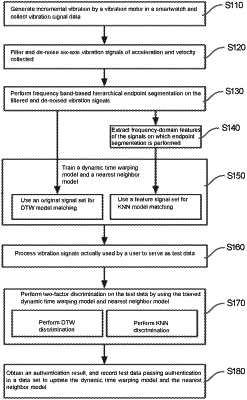| CPC G06F 21/35 (2013.01) [G01M 7/025 (2013.01); G06F 1/163 (2013.01); G06F 9/3001 (2013.01); G06F 18/214 (2023.01); G06F 18/24147 (2023.01); G06F 21/316 (2013.01)] | 20 Claims |

|
1. A method for authenticating a smartwatch using a vibration signal-based authentication, comprising the following steps:
step 1, generating an incremental vibration by using a vibration motor in the smartwatch and collecting six-axis vibration signals of a three-axis acceleration and a three-axis angular velocity;
step 2, filtering and de-noising collected six-axis vibration signals and performing a frequency band-based hierarchical endpoint segmentation on filtered and de-noised six-axis vibration signals to obtain the six-axis vibration signals at a plurality of frequency bands;
step 3, extracting frequency-domain features for the six-axis vibration signals at the plurality of frequency bands;
step 4, training a dynamic time warping model by taking the six-axis vibration signals at the plurality of frequency bands as a training data set, and training a nearest neighbor model by taking extracted frequency-domain features as training data;
step 5, collecting to-be-authenticated vibration signals, processing the to-be-authenticated vibration signals by step 2 and step 3 to form test data signals; and
step 6, discriminating similarities between the test data signals and training data signals corresponding to the test data signals through the dynamic time warping model, determining a classification result through the nearest neighbor model, and performing a weighted calculation on a discrimination result of the dynamic time warping model and a discrimination result of the nearest neighbor model, to obtain an authentication result.
|